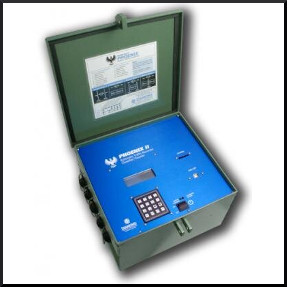Diamond Traffic Products Phoenix Classifier

Diamond Traffic Products Phoenix II is a 16 sensor classifier capable of using tubes, loops or piezos. Full telemetry is available to network installations. Real time access to traffic flow, vehicle and classification data across a network of instruments using a variety of sensors to suit minor roads to major freeways in one package.
Suited to mixed traffic applications, separate sensors can be run in bike lanes for bicycle counting with vehicle beings counted and classified in adjacent lanes.
The Phoenix II comes with a 4 line 20 character LCD display with a 16 alpha/numeric keypad, which can be used to program and view collected data as well as provide a real time test of the connected sensors on site.
Diamond Traffic’s Centurion Software can be used to set up the counter, download and analyse collected data and view real time traffic flow data on site or via the software’s telemetry features.
Austroads binning formats are available as well as the ability for users to tailor their own vehicle and speed classification bins.
Robust military specification connectors provide easy wiring of sensors, inputs and outputs of the Phoenix II unit.
Count 1-16 lanes
Classify 1-8 lanes
Sensor types include inductive loop, piezo, air tube and switch.
Independently counts some lanes and classifies others.
On board binning of data to Austroads or user configured binning tables.
Real time viewing of collected data and traffic flow on site or remotely.
User settable record intervals from 1 minute to 24 hours.
On board keyboard and display for setup and real tine viewing of data.
Modem and serial telemetry.
Optional USB communication.
Incident detection with the ability to program the classifier to report sensor failures, specific traffic conditions or warnings to a central office (via modem) and to local warning signs or VMS systems
High-end accuracy
Large memory capacity
Suitable for permanent installation or portable.
Can be integrated into a network of counters and classifiers linked by Diamonds Centurion Gold software via IP addressing or cellular modem.
Centurion CC or Gold used to setup, download and analyse data.
Post processing of data to user configured binning tables carried out in Centurion .
Ultra low power consumption
Built in Surge and RF protection
Size 30cm x 20cm x 30cm, 0.8mm thick aluminium formed case
Weight 5.4 - 8.1 kgs
Battery 6v 12AHr rechargeable Sealed Lead Acid gel type battery
Power Input 6-24VDC 6v@1500mA – 24v@400mA
Power Usage
6v at 150mA Maximum power draw. Typical current consumption is much less depending on sensor usage (less than 50mA average).
Memory 1MB On Board Battery Backed up SRAM.
32MB – 4GB SD/MMC flash card expansion
Sensor Inputs Eight contact closures or open collector to ground pulse inputs.
Four, Eight, Twelve, or Sixteen loop inputs (50-1800 microhenry) with press style contact closure or open collector emulation.
Up to Eight piezo inputs (standard or KISTLER Quartz direct) (BNC optional)
Output Four Optically Isolated programmable outputs.
Four Optically isolated Alarm triggers.
Four, Eight, Twelve, or Sixteen Optically isolated loop presence.
One, Two or Three RS232 ports at 115k baud.
One USB Peripheral B port.
Communication RS232 Serial: Direct PC connect at maximum 115k baud.
AT Hayes compatible modem connect at maximum 19200 baud.
2nd, 3rd ports for per vehicle data output and Piezo/I-Loop Programming.
USB Peripheral port B (front panel).
Firmware Flash upgradable firmware via main serial port with removable socketed EEPROM.
Onboard flash upgradable Piezo and Loop firmware via serial port.
Files
Counter can store up to 99 files in SRAM and an additional 65,000 in flash memory. Option of roll over when full is user settable.
Count Selection Mode Normal (Count and Binned modes), Subtraction, Directional
Classification Mode Selection Timestamp Sensor Event, Per-Vehicle Raw, Binned.
Record Time Intervals Selectable interval length of 1, 2, 5, 10, 15, 30 minutes, 1, 2, 4, 6, 12, 24hr.
Piezo Adjustable Settings Gain (1-8 for standard piezo), Threshold (1-255), Timeout (1-255).
Loop Adjustable Settings Frequency (16 separate frequencies per channel), Voltage (3, 4, 5, 6 Volts).
Dropout (1-255 Signal dropout threshold), Detect (1-255 Signal), Scan Rate (100-2000ms settable scan rates).
Keypad and Display Alpha/Numeric 16 key keypad with 4 line 20 characters per line LCD
Environmental IP42, -40°C to 72°C, 0-95% non-condensing relative humidity
Ballinger Technology Pty Ltd
Unit 20/23 Heyington Avenue Thomastown Vic 3074
Phone 03 93868722